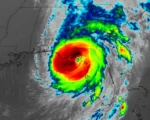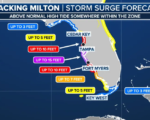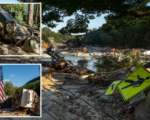Hurricane Helene made landfall late Thursday in Florida’s Big Bend region as one of the most powerful storms to hit the state in recent years. Packing sustained winds of 130 mph (209 kph), Helene, a Category 4 hurricane, has sparked widespread fears of catastrophic damage, fatalities, and extreme flooding, exceeding the levels seen in prior storms.
Even before making landfall, Helene wreaked havoc along Florida’s Gulf Coast, flooding large areas and leaving over 1 million people without power. State officials have issued urgent evacuation orders, warning that the storm’s surge—a dangerous wall of seawater driven inland by hurricane-force winds—could rise as high as 20 feet (6.1 meters), equivalent to the height of a two-story building. National Hurricane Center Director Michael Brennan described the situation as “unsurvivable” in some areas, with floodwaters potentially destroying homes and carrying vehicles.
The storm is already lashing Georgia, South Carolina, parts of North Carolina, and Tennessee with strong rain bands. In response, Atlanta, despite being hundreds of miles from Florida’s coast, has been placed under a tropical storm warning. The extreme rainfall is expected to exacerbate flooding across multiple states, while also threatening Georgia’s cotton and pecan crops, both of which are in the middle of their harvest season.
Florida Governor Ron DeSantis reported the first confirmed fatality on Thursday, though details were not immediately provided. Officials have drawn comparisons between Helene and last year’s Hurricane Idalia, which submerged 1,500 homes in low-lying areas. Already, water levels are rising in Pinellas County, where swamped roads and beachside flooding have been reported.
The storm has caused widespread disruption, with airports in Tampa, Tallahassee, and St. Petersburg suspending operations. As Helene moves inland, it is expected to remain a hurricane while passing through Macon, Georgia, and could bring over 12 inches (30.5 cm) of rain in its path, posing a severe threat to both rural and urban areas.
Despite mandatory evacuations, not all residents chose to leave. In Dunedin, Florida, just west of Tampa, 58-year-old Ken Wood, a ferry operator, decided to stay put with his 16-year-old cat, Andy. “We’re under orders, but I’m staying here. The storm looks like it’ll be a bit west of us, but who knows? It’ll be interesting, to say the least,” Wood said.
Taylor County authorities took more drastic measures, advising those who refused to evacuate to write their names and birth dates on their arms in permanent ink in case they needed to be identified posthumously. Meanwhile, reinsurance broker Gallagher Re estimates private insurance losses from Helene could total $3 to $6 billion, with additional losses to federal insurance programs potentially reaching $1 billion.
Energy production sites along the Gulf Coast have scaled back operations and evacuated staff to mitigate risk. Deanne Criswell, the Federal Emergency Management Agency (FEMA) director, announced that she would be traveling to Florida to assess the damage on Friday. According to the National Hurricane Center, Helene could dump as much as 15 inches (38.1 cm) of rain in some areas, raising the risk of flash floods and prolonged power outages due to downed trees and blocked roads.


















